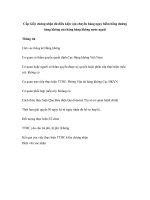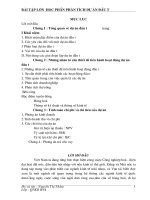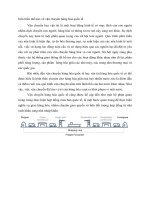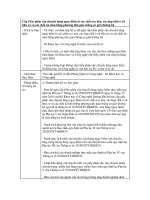THUYẾT TRÌNH VỀ BỘ LUẬT VỀ VẬN CHUYỂN HÀNG NGUY HIỂM (IMDG Code)
Bạn đang xem bản rút gọn của tài liệu. Xem và tải ngay bản đầy đủ của tài liệu tại đây (1.78 MB, 45 trang )
IMDG code
International Maritime Dangerous
Goods Code
Objectives
► Explain
the dangerous goods classification
► Recognize the IMDG labels
► Name the packing groups
► Name the proper documents
► Explain the DG cargo information flow
► Describe the stowage and segregation
requirements
► Explain how to work with the IMDG code
books.
Hazardous Cargoes
► Petroleum
products
► Chemicals( industrial,pharmaceutical,
agricultural )
► Minerals
► Animal products
► Plant products
► Radioactive materials
Class 1 EXPLOSIVES
► Class
1.1 mass explosion hazard
► Class 1.2 projection hazard, not mass
explosion
► Class 1.3 fire hazard minor, blast and/or
projection hazard, not mass explosion
► Class 1.4 no significant hazard
► Class 1.5 very insensitive, but mass explosion
hazard
Class 2 Gases
► Class
2.1
flammable gases
► Class
2.2
non flammable, compressed
► Class
2.3
poisonous gases
gases
Class 3 Flammable liquids
► Class
3.1 Flashpoint below -18oC
► Class
3.2 Flashpoint in range
-18oC to < 23oC
► Class
3.3 Flashpoint in range
23oC to 61oC
Class 4
Goods
► Class
4.1
flammable solids
► Class
4.2
solids or liquids spontaneously
► Class
4.3
dangerous when wet
Class 5 Goods
► Class
5.1 oxidizing agents / oxidizing
substances
► Class
5.2 organic peroxides
Class 6 Goods
► Class
6.1
poisonous substances
► Class
6.2
infectious substances
Class 7 Goods
RADIOACTIVE MATERIALS
Class 8 Goods
CORROSIVES
Class 9 Goods
MISCELLANEOUS
Product Containment
►1
Conventional packages
► 2 Intermediate bulk containers ( IBC )
► 3 Portable tanks and road tank vehicles
► 4 Bulk packaging and portable tanks for
solid dangerous goods
► 5 Limited quantities
Un 2823
DG declaration
DG note
DG packing certificate
Dg list









